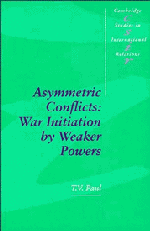Book contents
- Frontmatter
- Contents
- List of tables
- Preface
- PART I THE THEORETICAL FRAMEWORK
- PART II THE CASE STUDIES
- 3 The Japanese offensive against Russia, 1904
- 4 The Japanese attack on Pearl Harbor, 1941
- 5 The Chinese intervention in Korea, 1950
- 6 The Pakistani offensive in Kashmir, 1965
- 7 The Egyptian offensive in the Sinai, 1973
- 8 The Argentine invasion of the Falklands/Malvinas, 1982
- Conclusion
- Notes
- Bibliography
- Index
- Titles in the series
5 - The Chinese intervention in Korea, 1950
Published online by Cambridge University Press: 03 May 2011
- Frontmatter
- Contents
- List of tables
- Preface
- PART I THE THEORETICAL FRAMEWORK
- PART II THE CASE STUDIES
- 3 The Japanese offensive against Russia, 1904
- 4 The Japanese attack on Pearl Harbor, 1941
- 5 The Chinese intervention in Korea, 1950
- 6 The Pakistani offensive in Kashmir, 1965
- 7 The Egyptian offensive in the Sinai, 1973
- 8 The Argentine invasion of the Falklands/Malvinas, 1982
- Conclusion
- Notes
- Bibliography
- Index
- Titles in the series
Summary
On October 14, 1950 several divisions of the Chinese People's Liberation Army (PLA) crossed the Yalu River to confront the advancing US/UN forces in Korea under General Douglas MacArthur. China's decision to intervene militarily in the second stage of the Korean War against the far better equipped and well-trained US/UN forces is a major case of asymmetric war initiation in this century. The US, together with its coalition partners, possessed overwhelming advantages in the air and at sea, as well as a qualitative edge in artillery, tanks, and other key sources of modern conventional and nuclear military power capability. In some respects, this intervention is slightly different from other cases in this study as it was a pre-emptive attempt by the weaker side against a perceived threat to its security from the US, its main adversary at that time. Moreover, the Chinese offensive occurred after the initiator sent several warning signals with regard to its intention to intervene in protection of its interests and to deter an invasion of North Korea by the UN forces under General Douglas MacArthur.
Yet the question remains as to why the Chinese decision-makers, even after assessing their country's weaknesses vis-à-vis the US and other participating countries in the UN force, decided to commit their poorly equipped forces on the war path. Deliberations among them prior to the intervention reveal a clear awareness of China's disadvantages in fighting an adversary, far superior in all key aspects of military and economic power.
- Type
- Chapter
- Information
- Asymmetric ConflictsWar Initiation by Weaker Powers, pp. 86 - 106Publisher: Cambridge University PressPrint publication year: 1994
- 1
- Cited by



